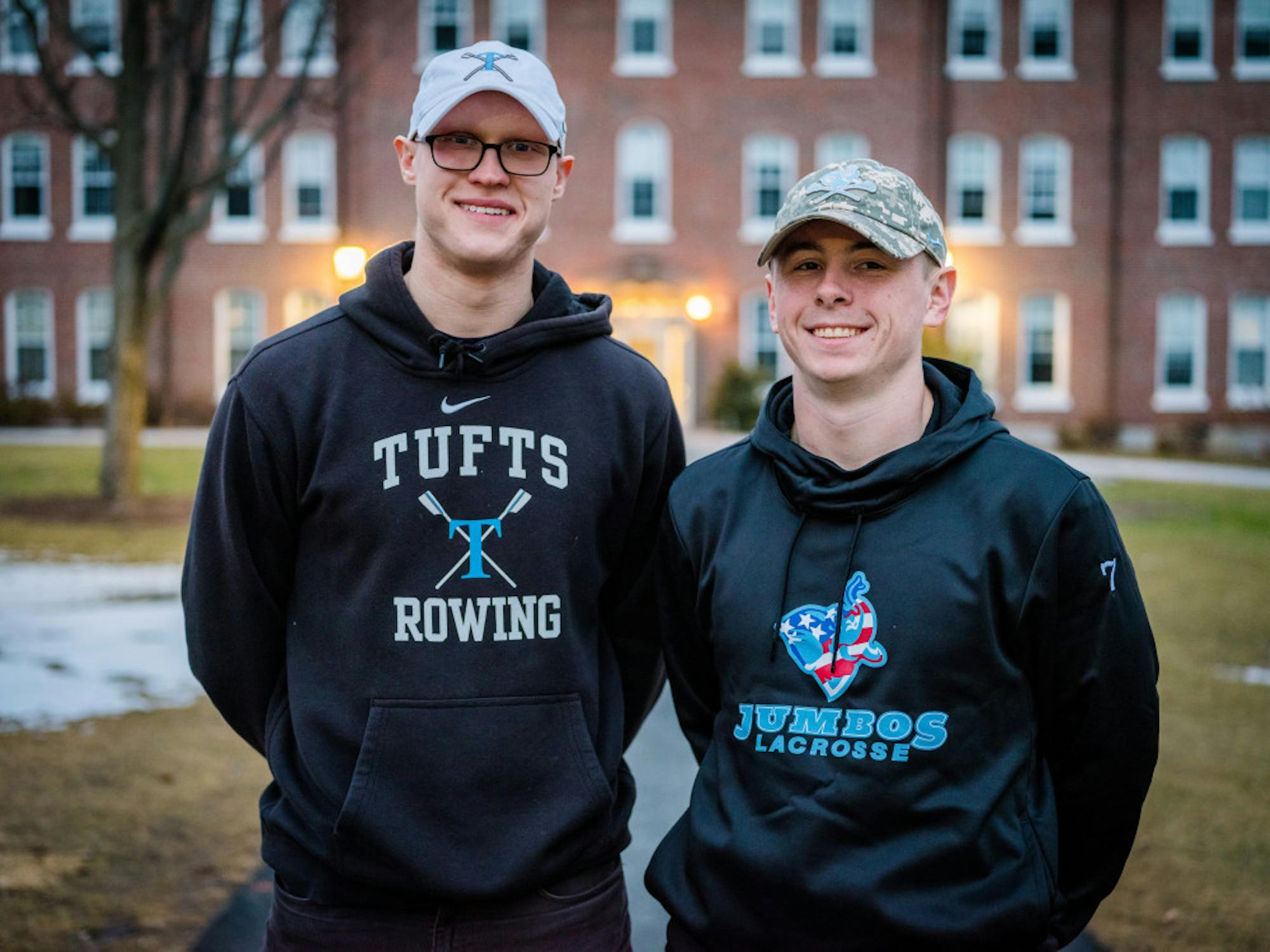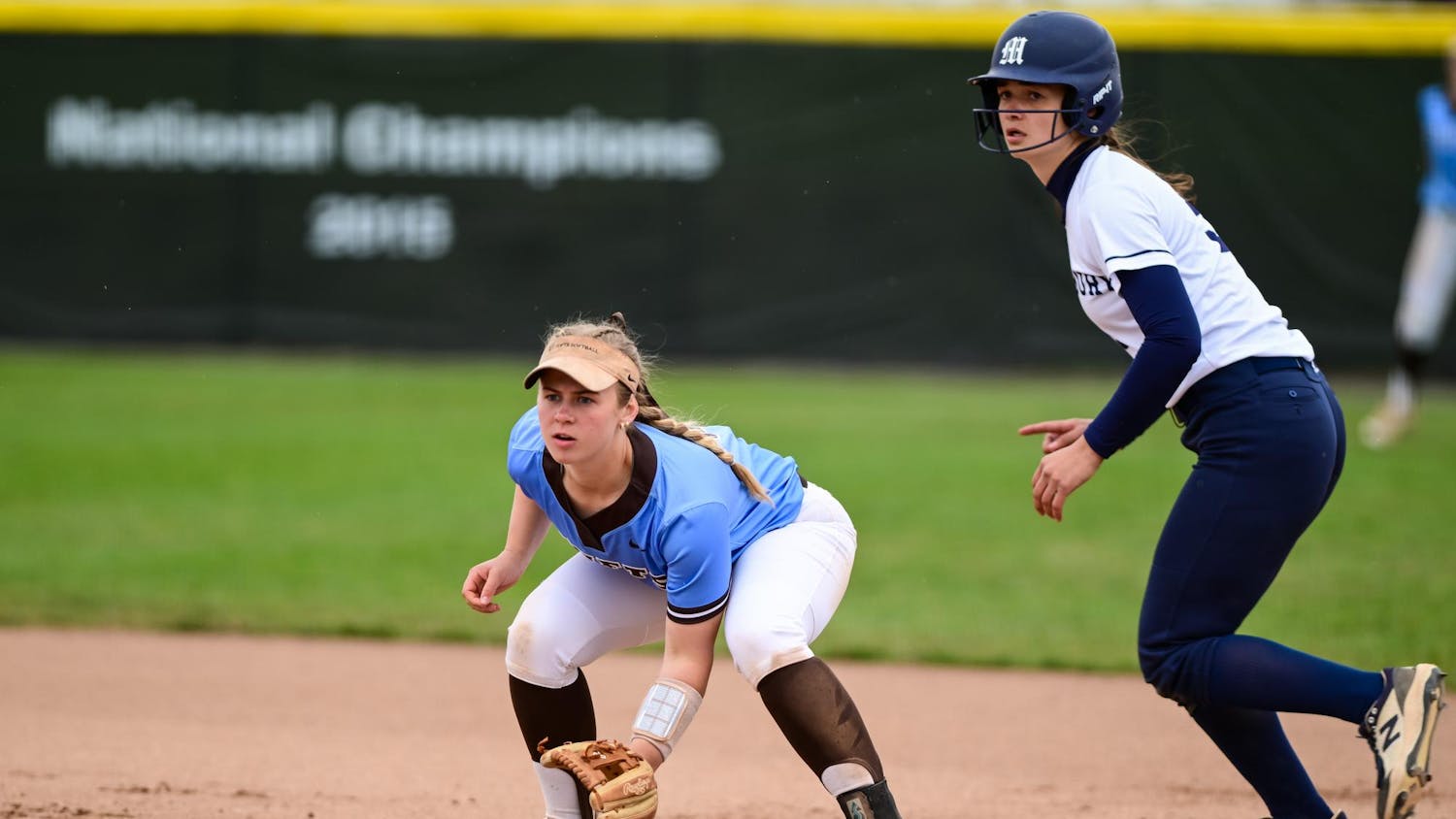For seniors Andrew Seiter and Tyler Hagedorn, school can sometimes feel like the least of their worries. Hagedorn and Seiter are the only two students at Tufts who are in the U.S. Reserve Officers' Training Corps (ROTC) and also play varsity sports.Hagedorn captains the men’s crew team, while Seiter plays attack for men’s lacrosse. Although the strenuous lifestyle is tough on both of them, Seiter and Hagedorn have found that, in tandem, the programs complement and benefit each other tremendously.
ROTC is a leadership program that is designed to educate cadets or midshipmen so that upon graduation, they are qualified to commission as officers in the U.S. Army, Navy or Air Force.At Tufts, there are five Army cadets, four Air Force cadets and seven Navy midshipmen.
After graduation from Tufts, Seiter and Hagdorn will be commissioned as Ensigns — officers in the Navy equivalent to second lieutenants in the Army and the Air Force — and will enter their Mission Occupational Specialities. Navy ROTC members have the chance to join either the Aviation Community, the Surface Warfare Community, the Submarine Community or the Special Warfare Community.Seiter will join Aviation, while Hagedorn will join Surface Warfare.
Seiter originally joined ROTC because of his relationship with his grandfather, Frank Bessenger, who served in the Navy for 20 years.Seiter, a native of Ridgewood, N.J., grew up listening to his grandfather's stories about his exploits in the Navy.When he was deciding where to attend college, Seiter's mom let him know about Navy ROTC at Tufts. With Seiter also being recruited for lacrosse, it was a perfect fit.
"Luckily, Tufts had Navy ROTC," Seiter said. "I joined the [ROTC] program on scholarship. It’s a big reason why I can afford to come here. I’m super lucky to have this opportunity."
Hagedorn’s story is similar: Both of his grandfathers served in World War II, and he, too, felt the urge to serve. The Chicago native was planning on attending the U.S. Naval Academy in Annapolis, Md., but after not getting accepted, he went to Hamilton College, where he joined the crew team. A year later, he transferred to Tufts because of the personal benefits offered by its ROTC program.
"You get a phenomenal leadership training, you get to see the world, you get to meet people from all sorts of different cultures and walks of life and you get to be a part of a really phenomenal organization," Hagedorn said.
Hagedorn’s crew coach, Noel Wanner, knew Hagedorn faced an uphill battle when he transferred to Tufts as a sophomore. Crew is a time-intensive sport, and Wanner wasn’t sure if his new rower would be able to cope with the dual responsibilities of varsity athletics and ROTC.
"What I said to him was that it [would] present a lot of challenges," Wanner said. "Every year, he has to miss some practices, and ordinarily as a coach, that's not something that I would permit. I made an exception for Tyler because he said he said he was willing to do whatever extra work it took to be a good team member."
Since that conversation, neither Wanner nor Hagedorn have looked back. Despite Wanner's warnings that the deck was stacked against him, Hagedorn proved himself through determination and hard work.
"What he's done ever since he got here has proven to me [that] he's capable of meeting both responsibilities," Wanner said. "He did a ton of extra work. He would come down to the boathouse alone in the afternoons to train by himself. He never missed a practice. As a result, his teammates came to see him as a leader."
For Seiter, balancing varsity athletics, ROTC, academics and everything else was overwhelming at first. But with time, he learned to manage his time better, often relying on support from his Tufts community.
"[As a first-year], it was like, 'here’s college academics, here’s college lacrosse, here’s Navy ROTC,'" Seiter said. "Improving is trying new things and finding out what works and what doesn’t. I’ve improved my work ethic over the four years, and that’s a testament to how much my team, coaches, teachers and midshipmen have helped me."
Tufts lacrosse coach Casey D’Annolfo believes that ROTC, while challenging, is of net benefit to Seiter’s time management skills.
"I think more than anything, ROTC demands a lot of time. It has forced Seits to have that great time management," D’Annolfo said. "The more you have on your plate, the more you have to compartmentalize. I think ROTC has forced him to do that, and he's done a great job with it."
Hagedorn agrees that the schedule was initially demanding. He’s adapted to the extra workload by changing his sleeping patterns. He doesn’t see it as a difficult thing to do — just something that’s part of the job.
"People tell me, ‘Oh, I could never do [ROTC].’ But that’s not true. Anyone could do it — you just have to have some discipline," Hagedorn said. "You wake up earlier and go to bed earlier. I go to sleep from 11–12 and wake up at six in season. There are naps for a reason."
So what is it about ROTC that takes up so much time? For one, Seiter and Hagedorn both take an extra class every semester, such as engineering, English, naval history or weapon systems.There’s a two-hour leadership class every Wednesday, as well as two physical workouts every week.Seiter and Hagedorn travel to either MIT or BU for every event, meeting up with fellow Navy ROTC members from MIT and Harvard.Because of those schools' conflicting schedules, everything is done in the morning.
"This is pretty standard across the country," Hagedorn said. "At a school like Tufts we don’t have a big enough unit. It’s a pretty resource-intensive training process, so we need numbers [from other schools]."
Seiter doesn't face many conflicts due to the nature of his lacrosse schedule. Most practices, workouts and games are in the afternoon. But for Hagedorn, the demands of crew create a big problem. The crew team practices almost exclusively in the morning, so his two commitments directly conflict.
"Certainly it’s not ideal, missing things for Navy or missing things for crew. But I’d like to think that I’ve managed it as best as I can," Hagedorn said. "It’s absolutely difficult to miss trainings, especially in the spring. When I miss practice in the spring, that means seven other rowers and a coxswain are affected."
During the fall semester, Hagedorn and Seiter held the two highest leadership positions within ROTC.Hagedorn was the Company Commander of the "Old Ironsides Battalion" (comprised of Tufts, Harvard and MIT students), while Seiter was the Battalion Commander for the entire Boston Naval ROTC Consortium — six schools and about 150 midshipmen.
As Company Commander, Hagedorn led 50 other Navy ROTC members in physical workouts on Tuesdays and a two-hour leadership course on Wednesdays.In his position, Seiter was responsible for the entire Consortium's training plan and overseeing its operations.
Lieutenant Hans Nowak II, one of Hagedorn and Seiter’s supervisors, believes that varsity sports and ROTC complement each other, especially in terms of leadership development.
"For varsity athletes, they develop a way to actually set a goal and have their team go and meet it," Nowak said. "Then they also gain a lot of communication skills. They definitely both go hand in hand with each other."
In fact, Nowak sees Hagedorn and Seiter as two of his strongest midshipmen — as exemplified by their high leadership roles in the fall — and he thinks their participation in varsity athletics has helped.
"Because they're such good leaders, they're ranked as my No. 1 and No. 2 first-class midshipmen," Nowak said. "We always support varsity athletics because we know that what they're developing on the field for lacrosse, or in the boat for crew, is not only going to make them more well-rounded individuals, but is going to make them better leaders for when they go out into the fleet."
Wanner agrees that there is overlap, especially in the physical trainings for both groups. He thinks Hagedorn’s personal willpower has been instrumental in his success.
"Some of the leadership skills he's learned [in ROTC] have transferred over well to the rowing program," Wanner said. "I know for a fact that the intense physical training program in rowing has helped him with the physical aspects of ROTC. It's not an easy road, but Tyler has shown a tremendous level of dedication and independent resolve.”
D’Annolfo has also seen Seiter develop his leadership and time management skills throughout his years at Tufts. While he’s not sure if ROTC is directly responsible, he’s confident that it has helped him to some extent.
"More than anything, Seits is a leader by example," D’Annolfo said. "In the last two years, I have noticed a huge growth in his verbal communication skills and leading through his voice. He's had that simultaneous leadership development both from lacrosse and ROTC. I think it has added a layer of maturity and accountability, as well.”
Hagedorn cannot imagine being at Tufts without participating in both athletics and ROTC.
"I don’t regret it, and I wouldn’t do it a different way," Hagedorn said. "There are sacrifices in doing anything."
Seiter concurred.
"I couldn't imagine being at Tufts and not doing both," Seiter said. "I wouldn’t be the same lacrosse player without ROTC, and I wouldn’t be the same midshipman without lacrosse."
Sports and service: exploring the lives of athletes in ROTC

Tyler Hagedorn (men's crew/Navy ROTC) and Andrew Seiter (men's lacrosse/Navy ROTC) pose for a portrait on Feb. 19.





